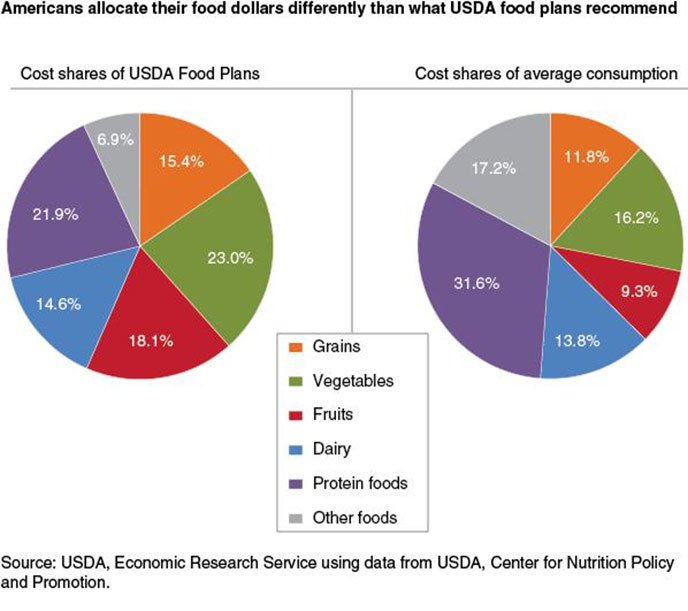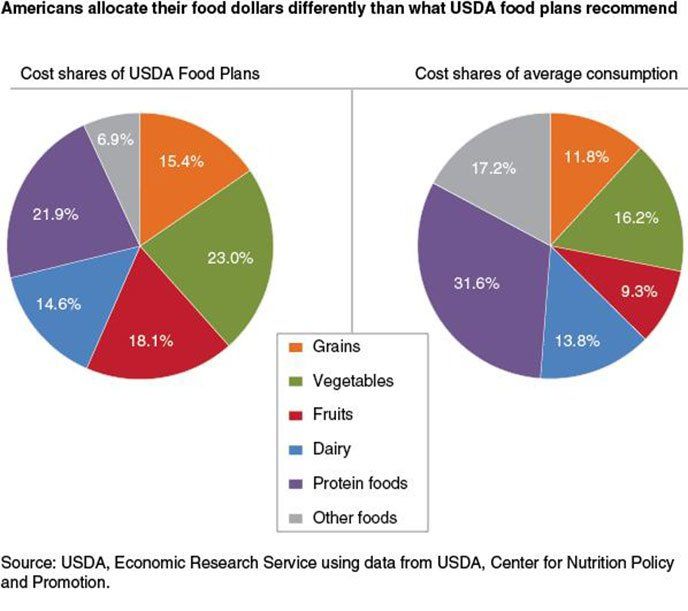A new USDA report concludes that following the dietary guidelines need not cost consumers more, but many Americans would need to re-allocate their food budgets. The analysis identified six changes that could improve consumers’ diet quality – none costing more and most actually saving money.
“Healthy food is not necessarily expensive,” says Parke Wilde, PhD, an associate professor at Tufts’ Friedman School who previously worked for the USDA’s Economic Research Service (ERS), which prepared the report. “It is true that some healthy food is high-priced, but many other healthy options are both tasty and affordable. Especially if we get a bit more of our food from grocery stores rather than restaurants, this research finds that we can maintain our health and protect our wallets at the same time.”
MONEY FOR MISC.: The ERS analysts began by acknowledging, “The average American does a poor job of following federal dietary guidelines.” Most people get too many calories from refined grains, solid fats and added sugars, and fail to eat enough fruits, vegetables and whole grains. But don’t such healthy choices cost more?
To see whether cost is really a barrier to healthy eating, researchers began with data from a 2011-12 national nutrition and health survey (NHANES). They scored adherence to dietary guidelines on a 100-point scale. Average scores ranged from 48.1 to 54.5, with little difference among income groups.
Data from a 2012-13 Bureau of Labor Statistics’ Consumer Expenditure Survey also show that households at all income levels spend their food dollars similarly. On average, Americans allocate 8-11% of retail grocery expenses to dairy products, 12-15% to bakery and cereal products, 17-19% to fruits and vegetables, and 21-28% to meat, poultry, seafood and eggs. The largest share of grocery spending among all income groups – about 35% – goes to “miscellaneous foods.” This broad category includes soft drinks and other sugary beverages, frozen meals, snacks, canned and packaged soups, salad dressings, candy, condiments, gourmet and specialty items, baby food and seasonings.
Except for baby food, that list contains many foods consumers could easily leave out of their grocery carts. Some are high in unhealthy fats, added sugars or sodium.
EAT BETTER, SPEND LESS: How could changes in your food budget buy a healthier dietary pattern? It’s true that spending more on groceries can improve your diet, if those dollars are spent on fruits, vegetables, whole grains, seafood and other smart choices. But the ERS study found it wasn’t necessary to spend more to boost healthy-eating scores. In fact, three of the positive behavior changes analyzed reduced costs while having the same or better effect as spending a dollar a day more on food. None of the healthy changes increased costs; daily savings ranged from zero to $1.19.
The greatest cost savings and dietary improvement came from substituting a table-service restaurant meal with one prepared at home, along with switching from fast-food to home cooking. Those changes don’t have to mean spending hours in the kitchen cooking from scratch, however: Prices reflected using convenience products, such as frozen vegetables, canned beans and bottled sauces.
Another change that paid off as much as boosting grocery spending was skipping weekend splurges. Eating the same on Friday through Sunday as on weekdays saved money and improved scores on the 100-point scale.
Slight improvements in healthy eating were also seen from shifting 10% of daily calories to lunch or breakfast and decreasing the share of calories from snacks.

MORE FOR PRODUCE: The researchers also compared how most Americans spend their grocery dollars versus food plans developed by the USDA that meet the dietary guidelines. (See chart.) By shifting the share of expenditures on fruits and vegetables from 26% to 40%, a family of four could buy the quantity and variety of produce needed, within the same budget. That slight adjustment would significantly expand the affordable options in the produce aisles, especially dark green and red-orange veggies – from only 24 budget-friendly choices to more than 100.
The USDA plans recommend freeing up that extra $20 a week by reducing spending on non-plant protein foods and miscellaneous (“other”) choices.
“Americans face a variety of challenges when trying to eat a healthy diet,” the ERS experts concluded, “but the total amount consumers currently spend on food is not the primary barrier to healthy eating.”
Spend $1 more per day on food: +$1.00/+1.9pts
Replace one fast-food meal: -$0.92/+3.2pts
Replace one table-service restaurant meal: -$1.19/+2.6pts
Eat the same on weekends as Mon.-Thurs.: -$0.22/+1.9pts
Increase share of daily calories from lunch by 10%: no change/+0.4pts
Increase share of daily calories from breakfast by 10%: -$0.12/+0.3pts
Decrease share of daily calories from snacks by 10%: -$0.08/+0.2pts
























